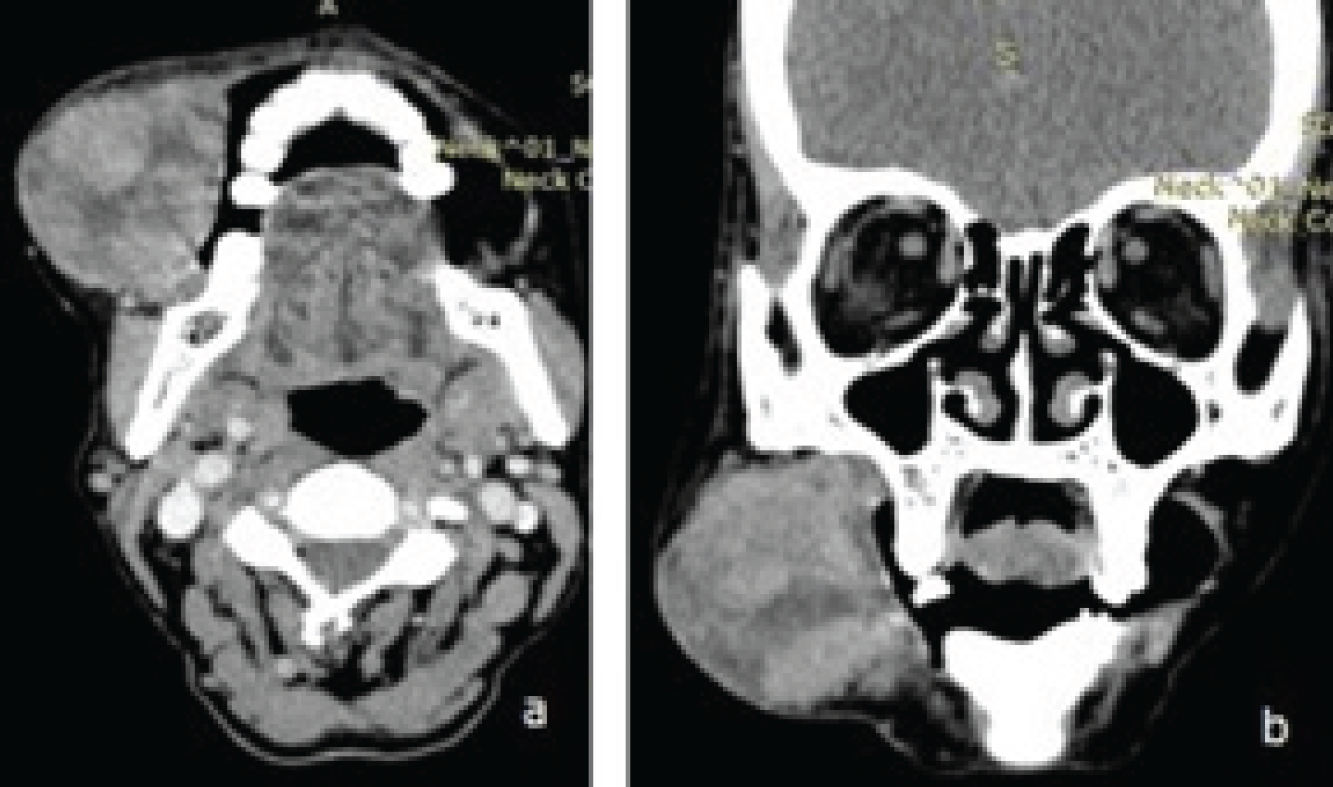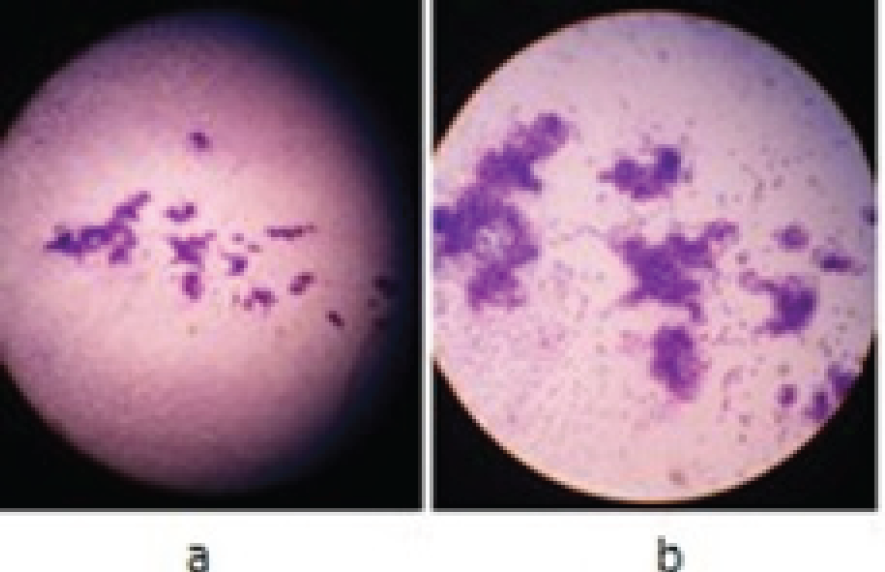Background
Monomorphic adenomas are epithelial tumors which are not pleomorphic. These have now been placed in a separate group because of the different morphological characters than pleomorphic adenoma. Minor salivary gland tumors form 15% of the salivary gland neoplasms. These are located at different locations [1]. Monomorphic adenomas are rare among minor salivary glands. These monomorphic adenomas show strong association of hamartomatous deviation from the normal organogenesis. There is some predilection for the upper lip and parotid glands. These are encapsulated slow growing masses which remain asymptomatic for a long duration. These have been mistaken as adenoid cystic carcinomas. The oral cavity contains 600 to 1000 minor salivary glands. The incidence is more noticed in the older age group. Monomorphic adenomas of basal cell type are uniform in cellularity without any myxoid or chondroid features. These are multicentric in nature and can be present at different sites. The incidence of occurrence at different locations can be as follow:
There are two classes of the lesions as one from the single layer and other from the two layers of cells. The former forms the group of monomorphic adenomas. Isomorphic adenomas are strictly formed by luminar epithelial cells. These are encapsulated tumors and shows partially cystic nature. These may be mistaken as adenoid cystic carcinomas as per the histological picture. There is a lot of expansion and remain monolobular in nature. The main differentiation is done from the pleomorphic masses on the grounds of cytology, histomorphology and peripheral growth pattern. Ultrasonography will define the contents of the mass and the internal necrotic contents. CECT and MRI play a pivot role in the extension and relationship with the adjacent structures. The level of enhancement can indirectly highlight the vascularity of the tumor [2]. The differentiation of the tumors for benign and malignant nature can be done by the dynamic scan in MR imaging. The calculations were made against time-signal intensity curve for the time of peak enhancement and wash out ratio. This has got 91% each sensitivity and specificity in differentiation [3].
Case presentation
A sixty years old female reported to the outpatient department of otorhinology with swelling on right side of the face. There was a gradual increase in the size of the swelling. The swelling was asymptomatic in the beginning but became slightly painful as the size enlarged (Figure 1). There were some socio-cosmetic reasons for which she reported for the treatment of this swelling.
She was of averagely physical built. Her systemic examination was unremarkable. Locally, on examination, this swelling was present on the right cheek and measured 5.0 × 5.5 cm. This was soft and non tender. There was no skin discoloration over the swelling. On examination, the buccal mucosa was of red color without any ulceration. All the biochemical parameters were within normal limits. Ultrasound examination had revealed this as soft tissue mass which was slightly echogenic with a few areas of necrosis. No calcification was seen (Figure 2a).
On color flow imaging (CFI) there was no blood flow noticed in the swelling (2b and c). Contrast-enhanced computerized tomography was done and this revealed enhancing encapsulated mass with a small region of non-enhancement representing necrosis (Figure 3a and b). Magnetic resonance imaging revealed hypo- to isointense mass which was encapsulated and had shown enhancement with few regions of intense enhancement. There was no extension to the adjoining bone or the muscle components (Figure 4a, b and c). Fine needle aspiration cytology was carried out which confirmed the diagnosis (Figure 5).
The patient underwent total surgical excision in one of our associated hospitals and had been followed up after one month without any complaint. Further follow-up had been advised at three and five months. Histopathological specimen confirmed the diagnosis.

Ultrasonography of the left cheek, (a) Grey scale images shows an oval shaped will encapsulated hetroechoic lesion in right buccal mucosa adjacent to right parotid gland with no obvious invasion of adjacent structures. The lesion had shown a few internal necrotic anechoic areas, (b and c) Color flow imaging had shown the peripheral vascularity around the lesion with a few foci of internal vascularity.

Contrast enhanced computerized tomography (CECT) of face, (a) axial section shows well demarcated lesion on the right cheek originating from the buccal mucosa. There is subtle enhancement with a few regions of necrosis, (b) coronal section of the same lesion highlights non – involvement of the underlying bone and overlying skin.

Magnetic resonance of the same patient, (a) T1W axial image shows well defined hypointense lesion, (b) T2W image shows the lesion as hyperintense with well marginated hypointense capsule, (c) Short tau inversion recovery (STIR) image show the same lesion stands out as hyperintense with the suppression of fat in the background. A few regions of hyperintensities are seen within the pathology representing as necrosis.

Photomicrograph of the cytology picture, (a) smear shows high cellularity, showing epithelial cells arranged in clusters and singly dispersed at places, Individual cells are showing round to oval nuclei, scant amount of cytoplasm and scant stroma in the background of blood and blood components suggestive of monomorphic adenoma, (b) Magnified image of the same pathology.
Discussion
Salivary tumors are slightly uncommon and monomorphic adenomas lists among still less common. Batsakis and Brannon [4] have classified the entity on the histological grounds into the following groups:
arising from terminal duct as basal cell adenoma and canalicular adenoma
arising from terminal or striated duct as sebaceous adenoma and sebaceous lymphadenoma.
arising from striated duct as oncocytoma, papillary cystadenoma and lymphomatosum
excretory duct origin tumors as sialadenoma papillefrum or inverted duct papilloma
Though the exact etiology of these tumors is not known but smoking, vitamin A deficiency and genetic predisposition are considered as the associated factors [5]. The diagnosis of these tumors remains elusive because of their slow growing as well as asymptomatic nature. Ultrasound-guided core needle biopsy is radiation free and safe method for the pathological diagnosis with almost 97% accuracy. This can be performed as outpatient procedure avoiding any hospital stay [6]. The management is for the wider excision of the tumor as there are chances of relapse. The periodic follow-up is necessary in the post-operative period. In malignant pathology, there is role of post-operative radiotherapy with a dose of 60 Gy and of non resectable tumors with 66 Gy [7].
Conclusion
The swelling on the cheek can raise various diagnostic dilemmas as the site for epicenter of the origin of tumor becomes difficult. The presenting features of the swelling are delayed because of the painless nature of the entity. The cytopathological features after cross section imaging confirms the diagnosis to unveil the mystery. The proper management can be undertaken if the nature of the tumor and the staging are confirmed. The surgical wide excision is the answer for these tumors with regular follow as these have got tendency for relapse.


